Latest updates
Sydney protesters determined to march
Sydney protest organisers say whatever the outcome of today's proceedings in the NSW's Supreme Court, they will march on Tuesday.
Protest organiser Padraic Gibson said while they understand the risk of COVID-19 in Sydney, they will do all they can to enforce safety measures.
Mr Gibson said face masks and hand sanitiser will be available and social distancing will be enforced.
He urged protesters to avoid crowding on public transport and consider riding or walking to the event.
"If you have any symptoms, stay at home. We don't want you to come to the demonstration," Mr Gibson said. "We are going to do everything we can to make sure our event is safer."
The matter will be heard at 2.15pm.
How to make the right cloth mask
By Dana McCauley
Australian researchers have compared home made face masks with medical surgical masks and found that at least two layers of fabric are likely needed to curb the spread of COVID-19.
The study, published in the British medical journal BMJ on Thursday, found that while a single layer of fabric "is better than no face covering", two layers performed "significantly better" at reducing the droplet spread caused by coughing and sneezing.
A three-ply surgical mask was the best performer among all the tested scenarios in preventing droplet spread from any respiratory emission, including airborne particles, and researchers found the best way to emulate this with a fabric mask was to use one made with three layers, but that two layers were still better than one.
Researchers from the University of NSW used a tailored LED lighting system and high-speed camera to capture the light scattered by droplets and aerosols expelled during speaking, coughing and sneezing while wearing different types of masks.
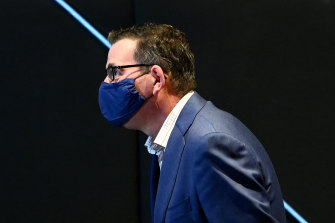
For Melbourne and Mitchell Shire residents, face masks are mandatory. Credit:Getty Images
The single and double layered masks used were those recommended by the Centers for Disease Control and Prevention in the United States.
The one-layer covering was made using the CDC's "quick cut T-shirt face covering (no-sew method)" using a folded piece of cotton T shirt and hair ties, while the two-layer covering was prepared using the CDC's sew method.
A healthy volunteer was filmed after inducing a sneeze by using a tissue paper to simulate the mucus membrane of the nasal cavity.
The cloth coverings were made from 175 GSM cotton fabric with a thread count of 170 TPI and the surgical mask used was a three-ply Bao Thach face mask.
The research paper said factors that determined the efficacy of cloth masks included the type of material used, the number of layers, the arrangement of different layers and frequency of washing.
"Viral droplets are generated during coughing, sneezing, or speaking," the authors wrote. "Face masks are thought to protect healthy people from inhaling infectious droplets as well as reducing the spread from those who are already infected, but worldwide shortages ... have led some health agencies, such as the US Centers for Disease Control, to recommend the use of home-made cloth face coverings as an alternative to surgical face masks."
The researcher said guidelines on home-made cloth masks "should stipulate multiple layers" and that there was a need for more evidence "to inform safer cloth mask design."
"Countries should ensure adequate manufacturing or procurement of surgical masks," they wrote.
Police seek fresh prohibition order for Sydney Black Lives Matter protest
By Michaela Whitbourn
NSW Police are seeking a Supreme Court order prohibiting a planned Black Lives Matter march in Sydney on Tuesday. The hearing will start at 2.15pm today.
Protest organiser Padraic Gibson is coordinating the rally on behalf of the family of David Dungay Jnr, a Dunghutti man who died in Long Bay Gaol in December 2015 after prison guards pinned him down when he refused to stop eating biscuits.
Police Commissioner Mick Fuller has suggested protesters at the march will be fined for breaching public health orders even if police fail to get a prohibition order in court, a threat which appears at odds with a recent NSW Supreme Court decision.
In a decision on July 4 this year, Supreme Court Justice Christine Adamson refused an application by NSW Police for an order prohibiting a Black Lives Matter march in Newcastle on July 5, shortly before the outbreak of COVID-19 cases in Melbourne.
Justice Adamson said that if the protest was authorised, as it was in the Newcastle case and an earlier march in Sydney on June 6, participants would not be liable for breaching public health orders.
A prohibition order would not ban the march outright but would leave participants exposed to criminal sanction for attending, including for blocking roads.
Justice Adamson said "the importance of free speech as exemplified by public political gatherings does not need to be established" and "it is regarded as a hallmark of a democratic society".
Justice Adamson weighed up the risk then posed by COVID-19, before the Victorian outbreak, and said NSW Chief Medical Officer Dr Kerry Chant had given her opinion that "the risk posed by the protest is low".
She said at the time that it was "of significance that the protest is to take place at a time when many other activities which involve the gathering of people have been allowed", including sporting events. Each case is decided on the facts at the time, including the risk posed by COVID-19
On Thursday NSW Health Minister Brad Hazzard and Treasurer Dominic Perrottet urged protest organisers to reconsider the march.
"Now is not the right time to be on the streets and intermingling with each other," Mr Hazzard.
Black Lives Matter protesters speak ahead of court appearance
Organisers of a Black Lives Matter protest are addressing the media outside the Supreme Court before their matter is heard at 2.15pm. NSW Police are seeking a prohibition order for a planned march by the group on Tuesday.
Speakers include Rhonda Dixon-Grosvenor, Gadigal, Dharug and Yuin Aboriginal Elder, Paul Francis, Nephew of David Dungay Jnr and Protest organiser Padraic Gibson.
About 4000 people have responded to the Facebook event.
Fined driver claims they didn't know about stay at home direction
By Simone Fox Koob
Three people travelling from Melbourne's outer south-east to the city's west to go to a friend's house have been fined by police after they claimed they didn't know about coronavirus restrictions.
The trio were travelling from Pakenham to Melton - a trip of over 100 kilometres - when they were stopped and fined by police. The driver claimed they didn't know about the stay at home directions.
Victoria Police doled out a total of 47 fines to individuals for breaching the Chief Health Officer's directions on Wednesday. Three of these were issued at vehicle checkpoints.
Five people were also fined for gathering and drinking in a park in Cranbourne.
Police checked 22,890 vehicles at the checkpoints on main arterial roads and conducted 4,544 spot checks on people at homes, businesses and public places across the state.
'Rashes, swollen hands and feet': The unusual symptoms of coronavirus
By Melissa Cunningham and Aisha Dow
Blotchy and itchy rashes. Swollen, inflamed fingers and toes. Elderly people arriving in emergency departments confused and disoriented.
These are just some of the myriad symptoms nurses and doctors on the front line of the COVID-19 pandemic are seeing in Melbourne's major hospitals as they treat more coronavirus patients than ever before.
The state recorded another 403 cases of COVID-19 overnight and five more Victorians, including a man in his 50s, have died in the past day.
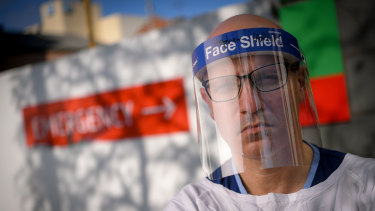
Emergency doctor Stephen Parnis. Credit:Eddie Jim
Three aged care residents - a woman in her 70s, a man in his 80s and a man in his 90s - are also among those who died overnight. There are 201 people in hospital with COVID-19, including 40 fighting for their lives in intensive care.
Emergency physician Stephen Parnis, who works across three hospitals in metropolitan Melbourne, said coronavirus patients he had treated in the last week were aged from their teens to their 80s.
"We are seeing people of all ages," the former vice-president of the Australian Medical Association said.
Some patients were arriving in emergency departments gasping for breath.
New limits on expectant mothers, partners in hospital
By Paul Sakkal
New rules will apply to expectant mothers, their partners and support people in Victorian hospitals, Health Minister Jenny Mikakos has revealed.
An expectant mother will be able to have her partner or support person with her for the labour and birth.
After the birth, however, the woman's partner or support person will only be allowed to stay with her for two hours.
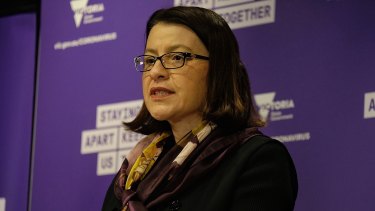
Health Minister Jenny Mikakos says visitors to hospitals and aged care homes will be limited.Credit:Luis Ascui
Visiting restrictions will also be tightened across Victorian hospitals more broadly and aged care homes as case numbers continue to rise among healthcare workers, nursing home staff and residents.
Visits will be limited to one person for one hour per day at aged care homes and hospitals.
There will be exceptions for parents with children in hospital and visitors of patients in palliative care.
Ms Mikakos said the changes were "designed to strike the balance between compassion ... and putting the safety of those residents and patients first".
Victorian Premier pleads to young people to follow rules as case numbers rise
By Paul Sakkal
Premier Daniel Andrews has appealed to young people, who make up more than a quarter of all COVID-19 infections so far this month, to follow lockdown rules to get through the second wave and slow the spread of the virus.
Mr Andrews, who stressed he did not want to lay blame at the feet of younger people, said there was growing evidence of healthy, younger people suffering serious illness, or death, from COVID-19.
About 25 per cent of all positive cases since the beginning of July have been Victorians in their 20s, according to the state government, compared with 6 per cent who are people in their 60s.
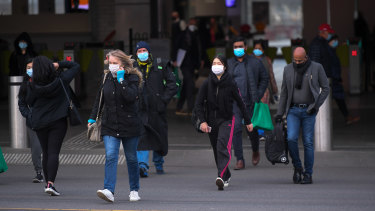
More young people are contracting and spreading COVID-19 in Victoria's second wave.Credit:Eddie Jim
"To people who are younger, if you want to get past these restrictions, if you want to get through this and get back to something approaching normal … the only thing to do is to get tested if you're sick and to isolate while you're waiting for a test," Mr Andrews said.
"To go and have a beer, or go and have a meal with a friend, or move around the community much further than you can now, you've got to follow the rules.
"Wear a mask when going out for one of the four reasons … it's pretty simple. It's pretty simple."
Government's forecasts could change depending on future lockdowns
By Jennifer Duke
It is possible the federal government's forecasts could change significantly over the next few months depending on any additional lockdowns to stop outbreaks of the virus across the country.
Treasurer Josh Frydenberg has warned forecasting is "difficult at the best of times" and obviously it is an even tougher task during the uncertainty of a global pandemic.
"These numbers reflect the harsh reality we find ourselves in," he said. "How we manage future cases of coronavirus will be absolutely key to the economic recovery, both the speed and trajectory."
He said the figures in this economic update are based on "what we know at the time". This includes assumptions in the forecasts that current lockdowns and border restrictions are gradually lifted, including the six-week shutdown in Victoria that is expected to ease by the end of the calendar year.
The new restrictions in Victoria, including the shutting of the border with NSW and a lockdown of Melbourne and the Mitchell Shire, will cost $3.3 billion and strip 0.75 percentage points from economic growth in the three months to September.
It's unclear what the effects of extending this shutdown on the federal budget would be, which Victorian Premier Dan Andrews warned this week could be a possibility.
"That is why learning from the lessons and experiences in Victoria will be critical," Mr Frydenberg said. "We do know that as the economy opens up and restrictions ease that jobs are being found."
'One-percenters' will help defeat virus, as key metric moves in positive direction
By Paul Sakkal
Premier Daniel Andrews says Victoria's "one-percenters" will help win the battle against COVID-19.
Those are the people who become infected, but spread the virus to just one other person. Ideally, an infected person does not spread the virus to anyone else.
Mr Andrews said the reproduction (R) rate had recently dropped to about 1, meaning each infected person, on average, was infecting one other person.
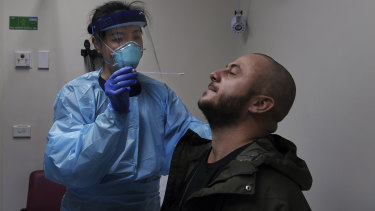
If Victoria's 'R number' falls below one, the second wave will start to ease. Credit:Kate Geraghty
He said Victorians doing the little things right, like isolating when needed, and gradual improvements in the government’s public health response, would contribute to driving the R number below one and stifling the second wave of the virus.
"If the [R number], so the number of people that a positive case infects, stays at one, then we will see stable numbers, but we will not see falling numbers," he said.
"If, however ... only every second person is infected … then we will see our numbers come down and come down again and again. That's what we have to get to.
"[It's] all about the one- and two-percenters, it's all about the small things, the small improvements in our internal processes, and in terms of compliance across the Victorian community that add up."
Most Viewed in National
https://news.google.com/__i/rss/rd/articles/CBMiyQFodHRwczovL3d3dy5zbWguY29tLmF1L25hdGlvbmFsL2Nvcm9uYXZpcnVzLXVwZGF0ZXMtbGl2ZS12aWN0b3JpYW4tZmFjZS1tYXNrLW1hbmRhdGUtYmVnaW5zLWFzLXN0YXRlLWFudGljaXBhdGVzLWZ1cnRoZXItc3Bpa2UtaW4tY292aWQtMTktY2FzZXMtYXVzdHJhbGlhbi1kZWF0aC10b2xsLXN0YW5kcy1hdC0xMjgtMjAyMDA3MjItcDU1ZWg3Lmh0bWzSAQA?oc=5
2020-07-23 03:04:00Z
CBMiyQFodHRwczovL3d3dy5zbWguY29tLmF1L25hdGlvbmFsL2Nvcm9uYXZpcnVzLXVwZGF0ZXMtbGl2ZS12aWN0b3JpYW4tZmFjZS1tYXNrLW1hbmRhdGUtYmVnaW5zLWFzLXN0YXRlLWFudGljaXBhdGVzLWZ1cnRoZXItc3Bpa2UtaW4tY292aWQtMTktY2FzZXMtYXVzdHJhbGlhbi1kZWF0aC10b2xsLXN0YW5kcy1hdC0xMjgtMjAyMDA3MjItcDU1ZWg3Lmh0bWzSAQA
Bagikan Berita Ini














0 Response to "Coronavirus updates LIVE: Victoria records 403 new COVID-19 cases and five deaths; Josh Frydenberg reveals Australia's biggest budget deficit since World War II - The Sydney Morning Herald"
Post a Comment